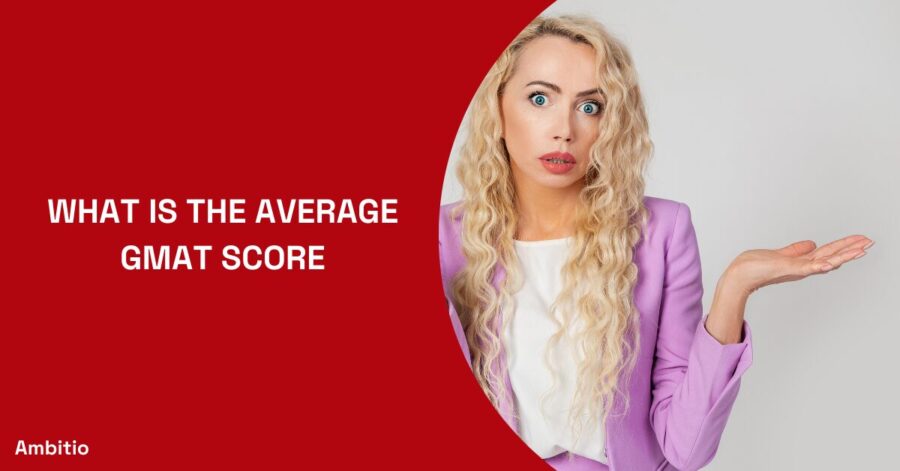16 December 2024
7 minutes read
Navigating the GMAT Landscape: Your Path to Top MBA Program in 2023

As prospective MBA students in 2023, the journey to securing a coveted spot in a top business school begins with understanding the significance of your GMAT score.
In this in-depth guide, we will delve into every aspect of the GMAT, from comprehending the average GMAT score for 2023 to mastering the test, finding the right balance between the GMAT and GRE, and acing your MBA application. So, let’s embark on this educational journey together.
Unraveling the Average GMAT Score in 2023
Understanding the Average GMAT Score
The GMAT score landscape for 2023 is dynamic, with each top MBA program setting its standards. However, a competitive GMAT score in 2023 generally falls between 670 and 720, showcasing the high expectations of business schools.
The Importance of the Average GMAT Score
Your GMAT score is more than just a number; it’s a reflection of your readiness for the rigors of an MBA program. We explore how the average GMAT score impacts your chances of acceptance and scholarship opportunities.
What Makes a Good GMAT Score in 2023?
Defining a Good GMAT Score
A good GMAT score is one that aligns with or surpasses the average score of your target MBA program. This section dissects what constitutes a strong score and its significance in the admission process.
Setting Your GMAT Score Target
Learn how to set a realistic GMAT score target based on your target schools and your own academic profile. Discover how to strike a balance between ambition and achievability.
Scoring Above 700: The Sweet Spot
Scoring above 700 is a notable achievement. Here, we explore the advantages of achieving this milestone and how it can enhance your MBA application.
Decoding the GMAT Test
The GMAT exam is a critical component of your journey toward an MBA. To succeed, it’s essential to understand this standardized test thoroughly. In this chapter, we will decode the GMAT by providing you with insights into its format, sections, scoring, and invaluable tips for effective preparation.
Understanding the GMAT Exam Format
The GMAT is a computer-adaptive test designed to assess your analytical, writing, quantitative, verbal, and reading skills. Here’s a breakdown of the exam format:
- Analytical Writing Assessment (AWA): This section includes one essay task where you’ll analyze an argument. It measures your ability to articulate and support complex ideas effectively.
- Integrated Reasoning (IR): The IR section assesses your ability to synthesize data from various sources and solve complex problems. It consists of graphical interpretation, table analysis, multi-source reasoning, and two-part analysis questions.
- Quantitative Reasoning: In this section, you’ll face multiple-choice questions that test your math skills, including arithmetic, algebra, geometry, and data analysis. It comprises two types of questions: Problem Solving and Data Sufficiency.
- Verbal Reasoning: The Verbal section evaluates your reading comprehension, critical reasoning, and sentence correction skills. It consists of Reading Comprehension, Critical Reasoning, and Sentence Correction questions.
Scoring on the GMAT
The GMAT is scored on a scale of 200 to 800, with 200 being the lowest possible score and 800 representing a perfect score. The score is derived from your performance on the Quantitative and Verbal sections, with each section scored separately.
The Integrated Reasoning section is scored separately on a scale of 1 to 8, and the Analytical Writing Assessment receives a separate score on a scale of 0 to 6. Your total GMAT score is based on the Quantitative and Verbal sections and typically ranges between 400 and 800.
The AWA and IR scores are reported separately on your score report. Admissions committees primarily focus on your total GMAT score, but some schools may also consider the individual section scores.
Effective Preparation Strategies
Preparing for the GMAT requires a well-structured plan and a commitment to practice and improvement. Here are some strategies to decode the GMAT effectively:
- Understand the Test Format: Familiarize yourself with the structure of the GMAT, the types of questions, and the time allocated for each section.
- Create a Study Schedule: Develop a study plan that includes specific goals, study materials, and a realistic timeline for preparation.
- Practice Regularly: The GMAT is as much about strategy as it is about content. Practice using official GMAT questions to get a feel for the test and improve your time management.
- Review Mistakes: Analyze your practice test results to identify weaknesses. Focus your efforts on improving in areas where you struggle the most.
- Simulate Test Conditions: Take practice tests under timed, test-like conditions to build your stamina and reduce test-day anxiety.
- Seek Additional Resources: Consider enrolling in a GMAT prep course or using GMAT study guides to supplement your preparation.
- Stay Healthy: Maintain a balanced lifestyle during your preparation. A well-rested and healthy mind performs better.
- Test-Taking Strategies: Learn time-saving strategies for each section, such as how to approach data-sufficiency questions or sentence correction.
By decoding the GMAT through diligent preparation, you’ll not only boost your chances of a competitive score but also build the skills necessary for success in your MBA program.
Strategies for GMAT Success
Mastering the GMAT requires more than just content knowledge; it demands a strategic approach to each section of the test. In this chapter, we will delve into specific strategies for GMAT success, offering insights and techniques to excel in both the Quantitative and Verbal sections.
Mastering the GMAT Verbal Section
The GMAT Verbal section assesses your reading comprehension, critical reasoning, and sentence correction skills. Here are strategies to excel in this section:
1. Reading Comprehension:
- Active Reading: Engage actively with the passages. Underline key points, jot down notes, and identify the main idea and supporting details.
- Structure Identification: Recognize the structure of the passage, including the introduction, body, and conclusion. Understand how ideas are connected.
- Time Management: Allocate about 2-3 minutes per passage, but don’t be afraid to invest more time in understanding challenging content.
2. Critical Reasoning:
- Identify the Conclusion: Start by identifying the conclusion of the argument. This helps you understand the author’s main point.
- Evaluate Arguments: Assess the strength of the argument and identify any assumptions or flaws. Look for evidence that supports or weakens the conclusion.
- Practice Deductive Reasoning: Develop the skill of deducing logical consequences from statements and recognizing valid inferences.
3. Sentence Correction:
- Grammar Rules: Familiarize yourself with essential grammar rules and sentence structure. This is crucial for identifying errors in sentences.
- Elimination Strategy: Use the process of elimination to identify incorrect answer choices. Often, it’s easier to spot errors than to choose the perfect answer.
- Conciseness and Clarity: Favor answers that are clear, concise, and maintain the intended meaning of the original sentence.
Cracking the Quantitative Section
The GMAT Quantitative section evaluates your mathematical skills, including arithmetic, algebra, geometry, and data analysis. Here are strategies for success:
1. Problem Solving:
- Understand the Question: Carefully read the problem and identify what it’s asking. Break down complex problems into simpler components.
- Plug-In Values: In some cases, it can be beneficial to plug in numbers to test equations or verify answer choices.
- Use Estimation: When time is limited, use estimation to narrow down answer choices quickly.
2. Data Sufficiency:
- Systematic Approach: Develop a systematic approach to data sufficiency questions. Always check each statement individually before combining them.
- Avoid Calculation: You often don’t need to calculate the actual values in data sufficiency questions. Focus on sufficiency rather than exact solutions.
- Recognize Patterns: Look for patterns in data sufficiency questions, especially when dealing with inequalities or number properties.
3. Time Management:
- Practice Under Time Constraints: During your preparation, simulate test conditions to improve your time management skills.
- Don’t Get Stuck: If a problem is particularly challenging, move on and return to it later. Don’t let one question eat up too much of your time.
- Mark for Review: Use the “Mark for Review” feature to flag questions you want to revisit at the end of the section.
Acing Your MBA Application
The Role of GMAT in Your MBA Application
Explore how your GMAT score fits into your overall MBA application and what admissions committees are looking for.
Crafting a Standout MBA Application
Tips and tricks for creating a compelling MBA application that showcases your unique qualifications and experiences.
Scholarship Opportunities and Your GMAT Score
Learn how a strong GMAT score can open doors to scholarship opportunities, potentially reducing the financial burden of your MBA program.
Beyond the GMAT: Top MBA Programs and Rankings
When considering pursuing an MBA, it’s essential to look beyond just your GMAT score. You need to identify the right business school that aligns with your career goals, aspirations, and learning style. In this chapter, we will explore some of the top MBA programs in 2023 and their rankings, helping you make an informed decision about where to apply.
Top Business Schools in 2023
- Harvard Business School (HBS): Harvard Business School consistently ranks among the top MBA programs worldwide. With a rich history and a reputation for producing influential business leaders, HBS sets high standards for its applicants. While the average GMAT score is competitive, typically around 730, it’s crucial to emphasize holistic aspects of your application, including your leadership experiences and unique qualities.
- Stanford Graduate School of Business: Known for its innovative approach to business education and its location in Silicon Valley, Stanford GSB is a top choice for many aspiring MBA students. The average GMAT score for Stanford tends to be around 740, but like HBS, the admissions committee looks for well-rounded candidates with impactful stories.
- The Wharton School at the University of Pennsylvania: Wharton consistently ranks among the top business schools globally. Its finance program is particularly renowned. While the average GMAT score hovers around 720, Wharton also values work experience, leadership potential, and a clear sense of purpose in applicants.
- MIT Sloan School of Management: With a strong emphasis on entrepreneurship and technology, MIT Sloan attracts students with a passion for innovation. The average GMAT score is typically in the range of 710-720, but applicants should also highlight their technical and entrepreneurial skills.
- Columbia Business School: Located in the heart of New York City, Columbia offers access to a vast network of opportunities. The average GMAT score for Columbia falls around 715-725, but showcasing your fit with the school’s unique programs and strengths is equally crucial.
- Kellogg School of Management at Northwestern University: Kellogg places a significant emphasis on teamwork and collaboration. While the average GMAT score is competitive at around 710-720, demonstrating your ability to work effectively in a team is vital.
- Chicago Booth School of Business: Chicago Booth is known for its rigorous analytical approach to business education. The average GMAT score typically ranges from 715 to 725, but your application should also highlight your analytical skills and how they align with Booth’s academic philosophy.
- Tuck School of Business at Dartmouth: Tuck is known for its close-knit community and strong alumni network. The average GMAT score usually falls around 720-730, but Tuck also values applicants who can contribute to its unique culture.
Rankings and Considerations
While these are just a few of the top MBA programs, it’s essential to research and consider various factors when choosing a school. Rankings can provide valuable insights, but they should not be the sole determining factor. Consider:
- Fit with your goals: Each program has its strengths and specialties. Choose a school that aligns with your career aspirations.
- Location: Consider the location of the school and how it may impact your opportunities for internships, networking, and post-MBA employment.
- Culture and community: Research the culture of the school and determine if it’s a place where you can thrive and contribute to the community.
- Financial considerations: MBA programs can be costly. Evaluate scholarship opportunities, financial aid, and the potential return on investment for your chosen school.
Conclusion
In 2023, the average GMAT score continues to be a vital factor in MBA admissions. Understanding what constitutes a good GMAT score and its significance can help you prepare effectively for your business school journey. Aim high, study diligently, and secure your place in a top MBA program.
FAQs
What is the average GMAT score for top MBA programs in 2023?
The average GMAT score for top MBA programs in 2023 typically falls between 670 and 720.
What is considered a good GMAT score for MBA admissions?
A good GMAT score is one that meets or exceeds the average score of your target MBA program. Generally, a score above 700 is considered strong.
How does my GMAT score impact my MBA application?
Your GMAT score demonstrates your academic readiness and can significantly influence your chances of acceptance and scholarship opportunities.
Can I submit GRE scores instead of GMAT scores for MBA admissions?
Some MBA programs accept either GMAT or GRE scores. Research your target schools’ preferences to choose the test that suits you best.

You can study at top universities worldwide!
Get expert tips and tricks to get into top universities with a free expert session.
Book Your Free 30-Minute Session Now! Book a call now




























